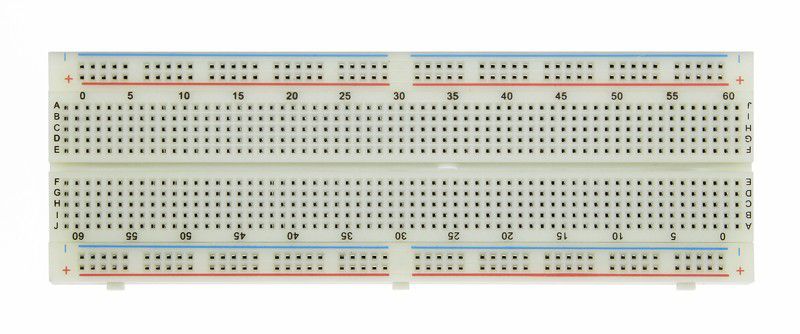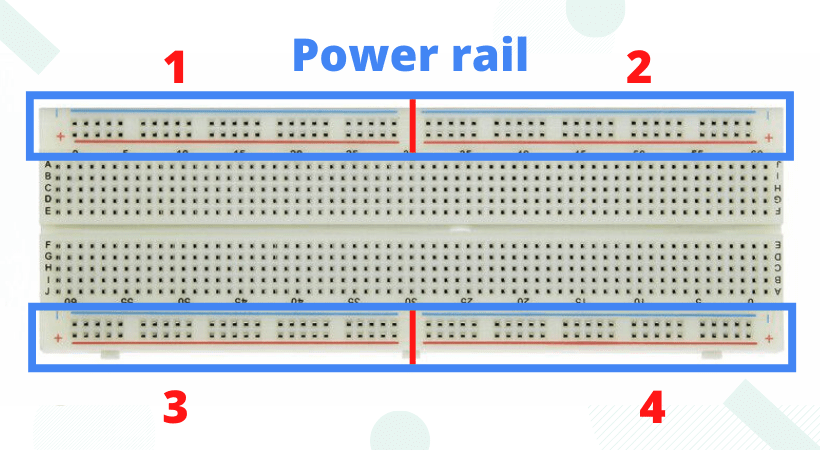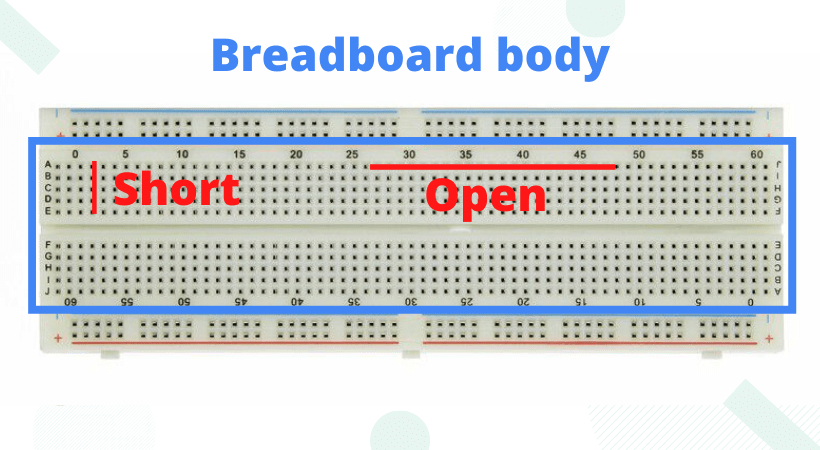The journey of electronics begins with making some basics projects. Almost all of the projects are first made on white dotted boards, which a lot of beginners have no idea of. The white dotted board is called the breadboard and in this article, we gonna explore the basics of a breadboard for beginners.
When I saw that white dotted guy, I thought what the hell is this but later on, I change my mind to what the hell to what an awesome tool to make circuits on.
In this article, we gonna see what a breadboard is,
- How the dots are connected
- How we can use these dots to our benefits when designing or doing our projects
- And of course, some basic projects including the very basic LED circuit on a breadboard
I am excited about this, lets get started. I hope you will enjoy it.
Breadboard basics for beginners
By basics of a breadboard for beginners, I mean how many portions are there in this simple-looking white, or any color, innocent device. Which portion is doing what and how I can use each portion in the right way to get my project done.
The basics also include some very basics electronics concepts i.e. the open and short circuits. Don’t worry if you have no idea right now what the hell I am talking about you will get it anyway.
But let start with the definition first.
Definition
A lot of you may have a rough idea that beadboard is a tool that we use to make projects, and you are right to some extent. Maybe there is no such proper definition at all for this guy but we gonna define it in our own easy way.
A breadboard is a very basic tool in electronics used to make circuit prototypes, to test our circuits, to compare the real-time results to simulation one, to build a part of a system and test it independently.
The definition is not that scary, just give it a time to digest. I am sure a lot of things will make sense to you as we go further in this article.
Why we use a breadboard
In electronics, or in general life, everything starts with an idea. You got an idea to do an electronics project, awesome! But when you are actually doing it there are chances you may get it wrong the first time, the second time, the third time, or in the worst case you don’t get it right and you give up.
You made your circuit on simulation software, seems to work fine in software. Great! Now, it is the time to actually made it on something, the breadboard, and of course who says you won’t make any mistake. You will, and you will make a lot.
The point I am making here, in practice, there are chances of making good mistakes. And breadboard is the only guy there who can actually be very helpful to undo your mistakes.
We use a breadboard to make changes to our circuit much faster in case something went wrong and to compensate for our mistakes efficiently.
The other good point to use it is to avoid burning up your devices by directly going for soldering. We solder components once we are sure of our design. Because once we are done with soldering it is very hard to make changes in the circuit. So, breadboard gives a solderless circuit making option which is great.
Now, we can say a breadboard is a solderless circuit making and testing device. Maybe if you are a newbie this concept may not be that easy to digest but you will get to know it once you do more projects and grasp more knowledge about electronics.
Portions of a breadboard
So, we got to know what a breadboard is now its time to go further with the article.
Let’s start the breadboard basics with learning about the different parts or portions of it. But first, let’s have a look at this guy if some of you haven’t seen it yet.

It is amazing, I know.
Just for information, there are many manufactures out there making different models. So some breadboards may look different in size, color, or shape. But don’t worry they do the same job and are exactly alike when it’s coming to circuit prototyping.
Power rails and the connections
The upper and below two rows of the breadboard are the power portions, called the power rail. Input power sources are attached to it and then distributed across the board by other external wires.

Further, each power rail is subdivided into two groups. In total there are four power portions you can use to attach four different levels of voltages. Sometimes when you are working with a project, you may need different voltages at a time. This could be a problem, so to solve this issue in breadboard you have four different power portions.
The two rows of power rail are connected short horizontal and are open in vertical to the other adjacent row. Conventionally, the upper row is used for negative potential and the lower row is used for positive potential. It is a convention, you are free to do whatever the way you like it.
If you connect a 5V to portion 1, then after the red line (see the above picture) in portion 2 there is no voltage at all. You can connect any voltage source to it, or you can copy the portion 1 into 2 if that is what your circuits demand.
The body portion and the connections
This the section where we make our circuit, make connections of various electronics components, connect resistors, capacitors, diodes, and integrated circuits (ICs). You have to be very careful when working with it. In case you missed it, or make a mistake, there is a good chance you may burn your devices.
And let me tell you it is totally fine to make mistakes and blow up your devices. This is the way you actually learn concepts. I remember all my early mistakes. Now I really laugh at them and remember how those silly mistakes have cost me of hundreds of rupees. But yeah, it was a learning journey, and still, it is.
Let’s take a look at it and discuss it in more detail below.

Column wise all the dots are short (connected) and row-wise all the dots are open. What does it mean? Well, it is that simple you connect a terminal of any device in any dot in any column, this means that now the entire column is the extended version of the terminal, connecting something to this column meaning connection it to the terminal of that particular device.
Pay attention at the side of the breadboard, you see there are labels from A to E and then from F to J. From A to E we count the number of rows is 5, and the number of columns is somewhat very large like its hard for me to count but still countable. Maybe if I counted it right it is a 5 x 60 matrix. The same goes for the other half i.e. from F to J.
Between the E and F row, there is a big gap, and it is differentiating the upper portion from the lower. Between the E and F, we connect our ICs. Imagine if connect the IC in the upper or lower portion we will end in shorting the legs of IC and can damage it permanently.
So in summary, we connect the IC between E and F, and all other components in the upper and lower portion. The upper two rows and the lower two rows are the power rails to which we can connect four different power sources. The column is short and is open form the adjacent columns. A row is open except for the power rail.
Practice project
The cool thing about learning electronics is you don’t learn it properly without doing it. Or maybe I am the only guy that think it this way, correct me if I am wrong.
The best way to learn the concepts I discussed above is by doing a practice project. And then I leave it to you. My advice would be without practice it is really hard to grasp the concepts very well. So if you a chance to get your hands dirty with a breadboard, I will encourage it.
The LED circuit on a breadboard
This is the first project of almost every electronics beginner, its cool and awesome to do. I always get the feeling of that very day when I myself first made it in our lab.
It is so simple yet very fun to make. I strongly suggest to try it out yourself.
For the LED project, you need the following components.
- 5V battery
- 1kOhm resistor
- LED
- Breadboard
- Multimeter
Make sure you have these requirements in hand so that you can follow the video and try to make one for yourself. Don’t worry if you don’t access the mentioned devices just watch the project carefully and try to understand everything.
Hopefully, you have fun watching it. They’re much more to learn in the same mentioned course. I would love to see you learn electronics.
Final words on breadboard basic
Learning breadboard basics for beginners are very too fun. It is fundamental to learn how to use a breadboard when you are getting started with electronics. It is among those basic things you must learn if you want to understand the world of electronics in a better way.
In electronics, our job is to find a solution to a problem by using the laws and rules of electronics. When we are in the process of finding the solution we try different things and see what can work better for us.
In simple words we make circuits and hence those circuits are not the final products. We are subjected to make mistakes and to compensate those mistakes we make use of the tool, we call the breadboard.
A breadboard is a tool we use to make circuits without permanently soldering the circuit components. You can say it is a circuit prototyping device that makes our lives easy when it comes to electronics system design. A proper definition would be like, a solderless circuit making device.
Why we use it anyway:
- To make circuit prototypes
- To test our ideas
- To compare results with simulation
- To quickly fix the issues in the electronics system
- To have fun with electronics and make cool projects on it
So that is a little summary of what we covered in the article. Now if you the guy who loves to read the summary and then decides to go for the full article. Well, maybe this article would be fun so please read it anyway.
I hope the article kinda helped you and you learned a little from me.
Other useful posts:
- Electronics basics for beginners (Easy learning electronics course)
- Multimeter basics for beginners – Learn how to use multimeter
- Major differences between Breadboard and Veroboard
Thank you so much and have a great life ahead.
